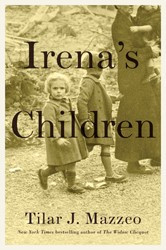By
– September 1, 2011
Many are familiar with the story of Irena Sendler, the young Polish woman who entered the Warsaw Ghetto and pleaded with parents to give her their children for safekeeping. She would give the babies or toddlers a few drops of a sedative and smuggle them out in various ways. Each child’s Jewish name and their new Polish name, would be dropped into bottles and buried under a tree in a friend’s backyard. Most of the rescuers were part of Zegota, the Polish Resistance, and their network of volunteers, orphanages, and convents that helped Jews and sheltered their children. What is less familiar is the story of the teens, who by dramatizing Sendler’s story, brought it to the attention of the world when previously, it was little known beyond Yad Vashem, where Sendler had been named one of the Righteous Gentiles.
A few non-Jewish teens, from a school district lacking any minorities, learned about Sendler and decided to write and act out her story. This was the result of the genius of one teacher who allowed his students freedom to research and present any topic in which they were interested. In this case, a single paragraph handed to a troubled student with a tragic family backstory, intrigued her and — formerly a loner — she acquiesced to her teacher’s suggestion that she work on the project with two other students. The three could not have been more different, had to adjust to one another and were, in the course of the book, vastly changed by their experiences and by the vagaries of fate. This book, then, is the story behind the story; it is both the story of Sendler’s life — before, during, and after the war — and the back stories of the three teens who so effectively undertook the initial effort to dramatize Sendler’s story that the demand for its performance increased. It is also the story of how they and their dramatization made Irena Sendler’s heroism known to the world. Beginning to feel such admiration and affection for their heroine, they were compelled to find out if Sendler was still alive. She was, though elderly and weak. They eventually developed a warm relationship with her, visited her several times in Poland and made her a heroine all over again. Not only can the reader learn about the Warsaw Ghetto and the touching personal story of Irena Sendler, but also the stories of three dissimilar teens, two of whom were very troubled, who became friends for life, and in a sense — “rescuers of the rescuer.” Sixty percent of the profit from the sale of the book is donated to the Irena Sendler: Life in a Jar Foundation.
A few non-Jewish teens, from a school district lacking any minorities, learned about Sendler and decided to write and act out her story. This was the result of the genius of one teacher who allowed his students freedom to research and present any topic in which they were interested. In this case, a single paragraph handed to a troubled student with a tragic family backstory, intrigued her and — formerly a loner — she acquiesced to her teacher’s suggestion that she work on the project with two other students. The three could not have been more different, had to adjust to one another and were, in the course of the book, vastly changed by their experiences and by the vagaries of fate. This book, then, is the story behind the story; it is both the story of Sendler’s life — before, during, and after the war — and the back stories of the three teens who so effectively undertook the initial effort to dramatize Sendler’s story that the demand for its performance increased. It is also the story of how they and their dramatization made Irena Sendler’s heroism known to the world. Beginning to feel such admiration and affection for their heroine, they were compelled to find out if Sendler was still alive. She was, though elderly and weak. They eventually developed a warm relationship with her, visited her several times in Poland and made her a heroine all over again. Not only can the reader learn about the Warsaw Ghetto and the touching personal story of Irena Sendler, but also the stories of three dissimilar teens, two of whom were very troubled, who became friends for life, and in a sense — “rescuers of the rescuer.” Sixty percent of the profit from the sale of the book is donated to the Irena Sendler: Life in a Jar Foundation.
Marcia W. Posner, Ph.D., of the Holocaust Memorial and Tolerance Center of Nassau County, is the library and program director. An author and playwright herself, she loves reviewing for JBW and reading all the other reviews and articles in this marvelous periodical.




